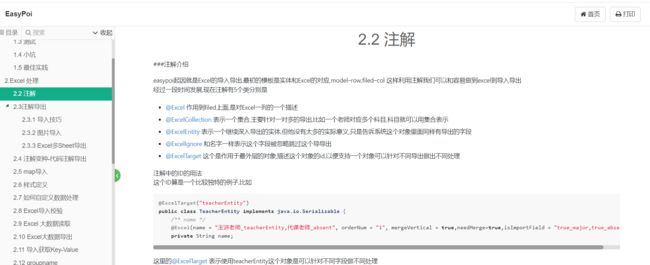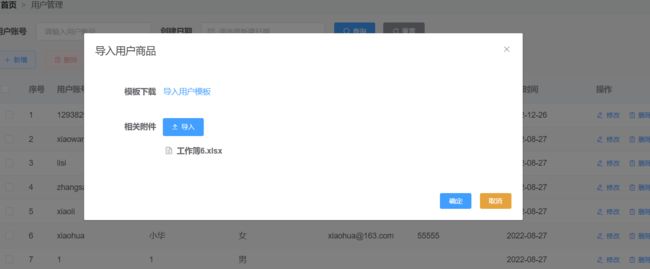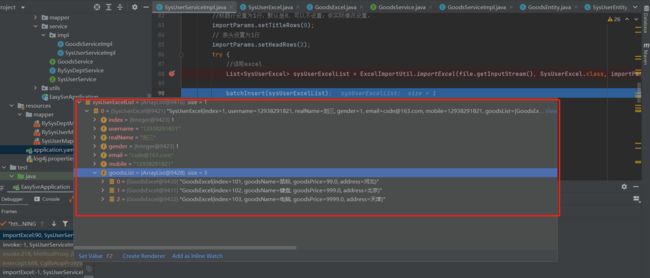微服务 Spring Boot Mybatis-Plus 整合 EasyPOI 实现 Excel 一对多 导入
文章目录
- ⛄引言
- 一、EasyPOI 实现Excel 的一对多导入 -- 代码实现
-
- ⛅需求说明
- ⚡核心源码实现
- 二、Easy POI 实现一对多导入 -- 测试
- 三、效果图展示
- ⛵小结
⛄引言
Excel导入 是 开发中 很常用的 功能 ,本篇讲解 如何使用 Spring Boot + MyBatis -Plus 整合 EasyPOI 实现Excel 的一对多导入。
EasyPOI官网
一、EasyPOI 实现Excel 的一对多导入 – 代码实现
⛅需求说明
采用 微服务 Spring Boot、Mybatis-Plus 整合 EasyPOI 实现Excel的一对多导入
Excel 导入 实现详细细节
- 前端采用 Vue+ElementUI 实现导入页面展示,要求弹出上传框、 展示导入模板、 并且要求文件手动上传
- 后端导入 要求实现EasyPOI实现、采用工具类完成导入的集合映射
- 要求使用 Mybatis-Plus 实现 批量导入
⚡核心源码实现
Excel 一对多导入如下所示
以上的商品信息该如何进行映射呢?
EasyPOI为我们提供了专门的映射集合的注解,@ExcelCollection
- 表示一个集合,主要针对一对多的导出,比如一个老师对应多个科目,科目就可以用集合表示
采用 注解进行映射即可
后端源码
SysUserExcel
package com.chen.excel;
import cn.afterturn.easypoi.excel.annotation.Excel;
import cn.afterturn.easypoi.excel.annotation.ExcelCollection;
import com.chen.entity.GoodsEntity;
import lombok.Data;
import java.util.Date;
import java.util.List;
@Data
public class SysUserExcel {
@Excel(name = "序号", orderNum = "0", format = "isAddIndex")
private Integer index = 1;
@Excel(name = "用户账号 *")
private String username;
@Excel(name = "真实姓名 *")
private String realName;
@Excel(name = "用户性别 *", replace = {"男_1", "女_2"})
private Integer gender;
@Excel(name = "电子邮箱", width = 25)
private String email;
@Excel(name = "手机号码 *")
private String mobile;
// 注解映射商品信息集合
@ExcelCollection(name = "商品信息")
private List<GoodsExcel> goodsList;
}
GoodsExcel
package com.chen.excel;
import cn.afterturn.easypoi.excel.annotation.Excel;
import cn.afterturn.easypoi.excel.annotation.ExcelCollection;
import com.chen.entity.GoodsEntity;
import lombok.Data;
import java.util.List;
@Data
public class GoodsExcel {
@Excel(name = "商品编号", orderNum = "0", format = "isAddIndex")
private Integer index = 1;
@Excel(name = "商品名称")
private String goodsName;
@Excel(name = "商品价格")
private Double goodsPrice;
@Excel(name = "收货地址")
private String address;
}
SysUserService
public interface SysUserService extends IService<SysUserEntity> {
ResultBean<PageInfo<SysUserDTO>> page(SysUserDTO param);
ResultBean<Integer> insert(SysUserDTO param);
ResultBean<Integer> importExcel(MultipartFile file);
}
SysUserServiceImpl
@Override
public ResultBean<Integer> importExcel(MultipartFile file) {
ImportParams importParams = new ImportParams();
//标题行设置为1行,默认是0,可以不设置;依实际情况设置。
importParams.setTitleRows(0);
// 表头设置为1行
importParams.setHeadRows(2);
try {
//读取excel
List<SysUserExcel> sysUserExcelList = ExcelImportUtil.importExcel(file.getInputStream(), SysUserExcel.class, importParams);
batchInsert(sysUserExcelList);
return ResultBean.create(0, "success");
} catch (Exception e) {
log.error("导入 Excel 异常! e ==> {}", e);
return ResultBean.create(10, "导入excel 异常!"+e.getMessage());
}
}
public void batchInsert(List<SysUserExcel> param) throws Exception{
//1.转换为dto集合
List<SysUserEntity> sysUserEntityList = BeanUtil.copyToList(param, SysUserEntity.class);
//2.转换为商品实体集合
List<GoodsEntity> goodsEntityList = BeanUtil.copyToList(param.get(0).getGoodsList(), GoodsEntity.class);
//3.转换集合
sysUserEntityList.stream().filter(obj -> obj.getUsername() != null)
.forEach(obj -> obj.setPassword("123"));
//4.批量保存
saveBatch(sysUserEntityList);
// 保存用户id至商品id
sysUserEntityList.stream().forEach(obj -> {
goodsEntityList.stream().forEach(goods -> {
goods.setUserId(obj.getId());
});
});
goodsService.saveBatch(goodsEntityList);
}
商品业务类
GoodsEntity
@Data
@TableName("tb_goods")
public class GoodsEntity {
private Long id;
private Long userId;
private String goodsName;
private Double goodsPrice;
private String address;
private Date createTime;
private Date updateTime;
}
GoodsService
import com.baomidou.mybatisplus.extension.service.IService;
import com.chen.entity.GoodsEntity;
/**
* @author whc
*/
public interface GoodsService extends IService<GoodsEntity> {
}
GoodsServiceImpl
import com.baomidou.mybatisplus.extension.service.impl.ServiceImpl;
import com.chen.entity.GoodsEntity;
import com.chen.mapper.GoodsMapper;
import com.chen.service.GoodsService;
import lombok.extern.slf4j.Slf4j;
import org.springframework.stereotype.Service;
/**
* @author whc
*/
@Slf4j
@Service
public class GoodsServiceImpl extends ServiceImpl<GoodsMapper, GoodsEntity> implements GoodsService {
}
前端源码
SysUserList Vue 部分
导入用户模板
导入
SysUserList JS 部分
data(){
return:{
userVisibleOnly: false
}
}
metheds:{
uploadSuccess(val) {
if (val.code == 0) {
this.$message.success("导入成功~");
this.getSysUserList();
}
},
handleExceed(val) {
},
clkBtnUpload() {
this.submitUpload();
this.$message({
showClose: true,
message: '上传成功,正在导入...'
});
this.userVisibleOnly = false;
},
submitUpload() {
this.$refs.upload.submit();
},
}
代码编写完毕,进行测试
二、Easy POI 实现一对多导入 – 测试
启动后端、前端 访问 : 127.0.0.1:80
导入测试
导入采用手动导入,点击确定后,将表单提交至后端
断点进入
我们看到已经完成了对象映射,直接进行映射对象,插入数据库即可
扩展知识:IDEA 断点快捷键 f8 按行进行断点调试、f9 进入下一次断点位置,若没有,直接结束
三、效果图展示
⛵小结
以上就是【Bug 终结者】对 微服务 Spring Boot Mybatis-Plus 整合 EasyPOI 实现 Excel 一对多 导入 的简单介绍,Excel一对多导入其实如此简单,Excel导入也是很常见的功能,希望带来这个案例,大家可以遇到需求时,进行举一反三,感谢支持!
如果这篇【文章】有帮助到你,希望可以给【Bug 终结者】点个赞,创作不易,如果有对【后端技术】、【前端领域】感兴趣的小可爱,也欢迎关注❤️❤️❤️ 【Bug 终结者】❤️❤️❤️,我将会给你带来巨大的【收获与惊喜】!




